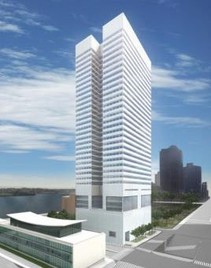Headquarters of the United Nations
Introduction
Text-to-speech Audio
Images
Le Corbusier (second from left) and Oscar Neimeyer (front and center) examine a model of their iconic design for the UN.

The UN's distinctive facade rising north-side along the side of Manhattan in what had previously been a slaughter-yard.

The enormous Fernand Léger murals inside the General Assembly room that sits 1800 people.

Visible for blocks down 47th Street, Saint George stabs the serpent in Zurab Tsereteli's sculpture "Good Defeats Evil."

The Secretariat Building and General Assembly on a cold November day.

A proposed rendering of the new UN tower designed by Fumihiko Maki.

Backstory and Context
Text-to-speech Audio
Two of the premier pioneers of modern architecture were selected to design the UN's buildings: the Brazilian Oscar Niemeyer and the French architect Le Corbusier. Like the UN's vision, their style of modern architecture was intended to transcend national boundaries and cultures. They each submitted plans that--through many negotiations--were eventually combined. The compromise resulted in the striking composition of a large block tower (Corbusier's design) situated within the elegant simplicity of Niemeyer's vision for an open vista from 1st Avenue to the East River. This decision along with the UN Secretariat's North-South orientation in a city where most buildings follow the East-West street grid, make it one of the most distinctive structures in New York's skyline. Breaking ground in September 1948, the UN Headquarters opened in 1952. In the years since its construction, the sheer blue-glass facade of UN Secretariat Building has become a symbol of international order and optimism. However, during major renovations in the 2010s, it was revealed that the building's original concrete floors had been reinforced with wire-mesh rather than with rebar, threatening the building's durability. Engineers conducted a stress test with heavy weights and precise measurements and reaffirmed that the building was secure.
Not only was Robert Moses (now most famous for his clashes with urban activist Jane Jacobs) successful in winning the bid to locate the UN Headquarters in New York, but he also won a fight to include a public playground on the land purchased by Rockafeller. Today, the UN Headquarters, including its extensive green spaces, are surrounded by gates and only open to UN delegates. The public may visit the UN Headquarters through official guided tours, which include visits to the General Assembly Hall, the Security Council Chamber, the Trusteeship Council Chamber, and the Economic and Social Council (ECOSOC) Chamber. The UN complex boasts numerous pieces of art given by members countries such as the large Fernand Léger murals inside the General Assembly and the Zurab Tsereteli's sculpture "Good Defeats Evil." Protestors of international human rights abuses can often be seen near the UN, especially in Dag Hammarskjöld Plaza on E 47th St. and Ralph Bunche Park between E. 42nd and 43rd. The UN General Assembly annual meeting convenes every September and brings thousands of diplomats and heads-of-state to Midtown East. Given the small size and confined location of the UN Headquarters, this meeting has been described as a logistical nightmare for the NYPD. In 2011 New York City agreed to give Robert Moses Park to the UN for the construction of a second tower in which to expand. Plans for the tower were published in 2013, but construction has not yet begun as of 2018.
Sources
Campbell-Dollaghan, Kelsey. "The UN Is Building an Emergency Back-Up Tower Next to Its Headquarters." Gizmodo. October 1, 2013. Accessed November 15. 2018. https://gizmodo.com/the-un-is-building-an-emergency-back-up-tower-next-to-i-1428765204
Davidson, Justin. Magnetic City: A Walking Companion to New York. New York: Spiegel & Grau, 2017.
History of New York City: A TLTC Blog. "United Nations Headquarters." November 14, 2016. Accessed November 15, 2018. https://blogs.shu.edu/nyc-history/2016/11/14/united-nations/#_ftn22
Mires, Charlene. “The Lure of New England and the Search for the Capital of the World.” The New England Quarterly 79, no. 1 (2006): 37-64.
UN Vistor Centre. "Tour." Accessed November 15, 2018. https://visit.un.org/content/tour-1
Gannon, Deven. "The history of the United Nations in NYC." 6sqft. October 24, 2017. Accessed November 15, 2018. https://www.6sqft.com/the-history-of-the-united-nations-in-nyc-on-its-72nd-anniversary/
Young, Michelle. "The 10 coolest secrets about the United Nations in NYC." Business Insider. October 23, 2015. Accessed November 15, 2018. https://www.businessinsider.com/coolest-secrets-about-the-united-nations-in-nyc-2015-10
Project on International and United Nations History at the Centre for History and Economics, University of Cambridge. "Architectural visions of the United Nations." Accessed November 15, 2018. http://www.histecon.magd.cam.ac.uk/internationalhistory/architecture.htm
UN Archives and Record Managment Section. "Oscar Niemeyer and the United Nations Headquarters (1947-1949)." Accessed November 15, 2018. https://web.archive.org/web/20141105002907/https://archives.un.org/content/oscar-niemeyer-and-united-nations-headquarters-1947-1949
